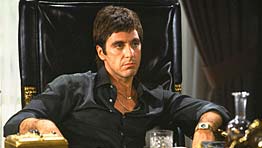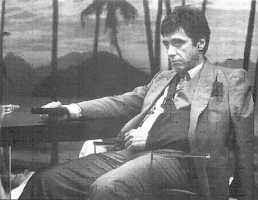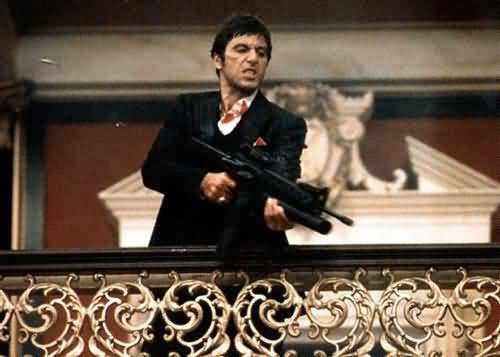
Summary 1: Al Pacino stars as Tony Montana, an exiled Cuban criminal who goes to work for Miami drug lord Robert Loggia. Montana rises to the top of Florida's crime chain, appropriating Loggia's cokehead mistress (Michelle Pfeiffer) in the process. Howard Hawks' "X Marks the Spot" motif in depicting the story line's many murders is dispensed with in the 1983 Scarface; instead, we are inundated with blood by the bucketful, especially in the now-infamous buzz saw scene. One carry-over from the original Scarface is Tony Montana's incestuous yearnings for his sister Gina (Mary Elizabeth Mastrantonio). The screenplay for the 1983 Scarface was written by Oliver Stone. Hal Erickson, All Movie Guide
Summary 2:Two-bit Cuban hood Tony Montana (Pacino) lies his way into the US, where he and his friend Manny (Stephen Bauer) soon enter the world of crime. They murder a political figure for drug dealer Frank Lopez (Robert Loggia) to get their green cards and are soon on his payroll. Tony's elimination of rival Colombian drug dealers gives him a more prominent role in the organization. His duties include serving as chauffeur to Lopez's beautiful but cocaine-addicted wife, Elvira (Michelle Pfeiffer). Tony's other female obsession is his sister Gina (Mary Elizabeth Mastrantonio). Tony's feelings for his sister are a bit on the incestuous side, and he dominates the girl, refusing to let her date. After a bad business deal and an argument over Elvira, Lopez attempts to have Tony killed. After killing the assassins, Tony murders Lopez, marries Elvira, and becomes the most powerful drug lord in Florida. The problems really begin to multiply then: Manny secretly dates Gina (though warned not to), Elvira has become increasingly zombie-like, and Tony's money is not earning the interest it should be. Moreover, he also has become a selfish, paranoid drug addict.


Infinitely quotable and more than a little cartoonish, Brian De Palma's update of Howard Hawks' seminal gangster film revels in its freedom to be larger than life. A work as akin to pop art as any other form, it reworks the crime melodrama in bold, primary colors, mostly blood red. Attracting a great deal of attention for its violence at the time of its release, the controversy overshadowed the fact that everything in the film ran to extremes, including Pacino's performance, the director's visual style (which found him almost reverting to The Fury mode), the dialogue (from a script co-written by Oliver Stone), and most importantly the themes. Scarface focuses on words like "crime" and "America," then lets itself run wild with the associations. That a classically American rise-and-fall story forms the heart of the film is its simplest and best irony. The experience will probably be thrilling to some, particularly those already enthusiastic about De Palma's work, and extremely off-putting to others. Tony Montana may not be an appealing character with which to spend nearly three hours, but there's little chance of forgetting the experience. Keith Phipps, All Movie Guide
